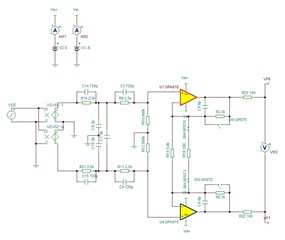Other Parts Discussed in Thread: OPA2863A, OPA863, OPA828
Hi Team,
We have a problem with too high quiescent current of opa810.
According to the datasheet, the current consumption of a single amplifier should be approximately 4 mA. Under standard conditions, this agrees perfectly with our observations.
The problem appears at higher input voltages, and especially, as we assume, at overdrives. The current consumption can then increase to up to 20 mA per amplifier. How to explain this phenomenon?
Our design is battery-powered, and we were a bit surprised by such a current consumption. By isolating fragments of a larger circuit, we have determined that the culprit was the input stage in a classic instrumentation amplifier configuration:

The resistance at the output of the amplifiers, as given in the diagram, is 3 kOhm. The output voltage level is +-9V. This gives an output current of 3 mA max. When added to the power supply current of the amplifiers, it theoretically gives a maximum of approximately 12 mA. When the amplifiers are overdriven with a constant signal, the current consumption of this part of the system coincides with these calculations and is about 15 mA. Increased consumption appears when an AC overdrive occurs and depends on the frequency of the overdrive. When we overdrive the system with a sine or square wave with a frequency of 1 MHz, the current consumption increases up to 43 mA (we suspect 20 mA for each amplifier + 3 mA for the amplifiers' output current).
The device is designed carefully, the noise and attenuation of the common signal (of the entire system, not only the parts from the diagram) are within the design limits (250 uV at output at 20 dB gain, CMRR > 60 dB for 1 MHz). There are no excitations, especially oscillations on the signal edges (checked up to 200 MHz). The distorted output signal has the shape that one would expect - with just clipped peaks:
Apart from increased power consumption, nothing bad happens. Simulations in Tina software do not show increased power consumption. Generally, they slightly underestimate the consumption, because they give it at the level of 10 mA (the entire part of the system) for full overdrive.
Can overdrive recovery state result in such an increased power consumption? Isn't this harmful to the amplifiers?
Regards,
Marcin

